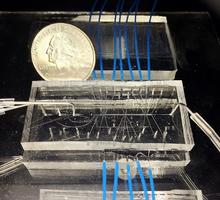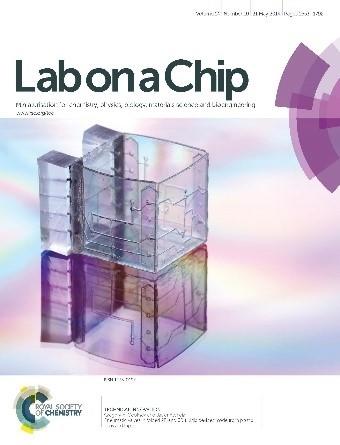Gregory A Cooksey (Fed)
Project Leader

Dr. Cooksey’s laboratory at NIST creates microfluidic tools that improve measurements and enable discoveries in physical, materials, and biological research. The lab has developed 2 world leading measurements systems, one for nanoflow metrology and a second for flow cytometry. Dr. Cooksey employs microfluidics with integrated optical systems to measure liquids and embedded particles such as cell or microplastics. The team uses an interdisciplinary and collaborative approach to biometrology: building uncertainty quantification into particle metrology utilizing physical models, innovative and robust measurement systems, and rigorous data analysis.
The team continues to advance the accuracy and dynamic measurement capabilities of small flows, recently demonstrating dynamic measurements of 1 nL/min with 5 % uncertainty and limit of detection of about 10 pL/min. The technique involves linking fluorescent properties of materials to the dosage of light they receive while flowing through an optical interrogation region.
The team also published the first direct uncertainty measurements in flow cytometry, which required novel flow control and analysis techniques. Work with collaborators in the Information Technology Laboratory is using signals analysis to improve counting, classification, and understanding of physical properties (e.g. size, shape, and deformability) of objects in flow.
These projects are part of the NIST on a Chip program and are supported by 2 NIST Innovation in Measurement Science (IMS) awards.
Greg Cooksey joined NIST in 2007 as a National Research Council postdoctoral fellow and is a biomedical engineer and Project Leader in the Microsystems and Nanotechnology Division. Prior to NIST he was a graduate student and postdoctoral researcher at the University of Washington, where he developed surfaces and microfluidic systems to study migrating cells and olfactory neurons.
Member Of
- Biophysical and Biomedical Measurement Group
- Microsystems and Nanotechnology Division
- Physical Measurement Lab
- NIST ON A CHIP
- NOAC: Microfluidics
SELECTED PROGRAMS/PROJECTS
Research Opportunities Available

Potential Research Topics include:
- High-throughput kinetic measurements and sorting using serial cytometry
- Multimodal characterization of micro- and nanoparticles, such as gene delivery particles, exosomes, and microplastics
- Optofluidic cytometry design and characterization
- Flow metrology; picoliter per minute measurements and dynamics
- Microdroplet packaging and measurement
- Cell-based microfluidic assays/diagnostics
- Physical modeling of dynamic systems in flow
- Design of novel microfluidic functionalities
We encourage interested post-doctoral and graduate research candidates to contact us to discuss project opportunities and fellowships.
Click here to go to our project listing with the National Research Council (NRC)
Click here to find out how to apply for an NRC Postdoctoral Fellowship
Summer research opportunities for undergraduates (SURF Program) and high school students (SHIP Program) may also be available.
Please contact me for more details or to discuss other ways to work together.





